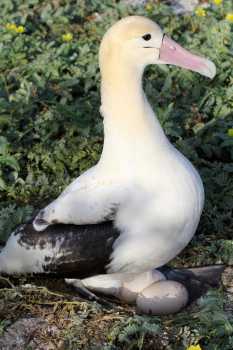The rarest of the three North Pacific albatross species, the Short-tailed Albatross Phoebastria albatrus has until last year only been documented breeding successfully on islands off Japan, despite increasing sightings of individuals amongst other albatross colonies in the USA's Hawaiian Islands in recent years.
A single female laid and then abandoned, infertile eggs on Midway Atoll in the Northwestern Hawaiian Islands from 1989-2001, but there was no indication of a male attending its nest. In late 2010 two Short-tailed Albatross nests were recorded in the Hawaiian Islands, both of which contained eggs that were incubated. The nest on Midway Atoll successfully fledged the first chick outside of Japan in June 2011 (click here), but the nest on Kure Atoll had failed by late December 2010 (click here).
Short-tailed Albatrosses have begun breeding on Kure Atoll again, and at the same nest site as in 2010. The first bird, an immature phase, arrived on 29 October 2011, followed by the second final-plumaged phase bird later the same day. On 30 October at 11h00 only the final-phase plumage bird was present with two eggs in the nest, the immature-phase plumage bird having already departed. These are the same 18-year old (13A 0703) and 11-year old (13A 1456) birds that were banded on Japan's Torishima Island by Hiroshi Hasegawa in 1993 and 2000, respectively as chicks and that bred together as a female-female pair on Kure last year. The 2010 nest was initiated on 31 October 2010.
Aside from the nest reported last year, Kure Atoll has had two previous reports of Short-tailed Albatrosses- one in 1994 and one in 2008. Both observations were within 300 m of the 2010 and 2011 nest site and were of immature-plumaged birds. It is possible that the pair on Kure Atoll has been attempting breeding for a number of years, but went un-noticed prior to the first winter field camp at Kure, which only occurred in 2010. So in previous years any nests that were initiated and then abandoned would likely have been missed by the time the camp was set up in May.

The older bird of the Kure female-female pair in 2010: with two infertile eggs
Photograph by Cynthia Vanderlip
As in 2010, the presence of two eggs this year is indicative of two females pairing whose eggs have a low probability of being fertile, particularly since they were laid in such rapid succession with no other Short-tailed Albatrosses present on the island.
The phenomenon of female-female pairing is relatively common amongst Laysan Albatrosses P. immutabilis, particularly in newly established colonies, and has also been documented in Black-footed Albatrosses P. nigripes, both of which are closely related to Short-tailed Albatrosses.
As with last year, we will keep our collective fingers crossed that this time there is a male Short-tailed Albatross involved and at least one of the eggs laid will be fertile. Stay tuned for updates.
With thanks to Cynthia Vanderlip for information
Lindsay Young, ACAP North Pacific News Correspondent, 4 November 2011

 English
English  Français
Français  Español
Español